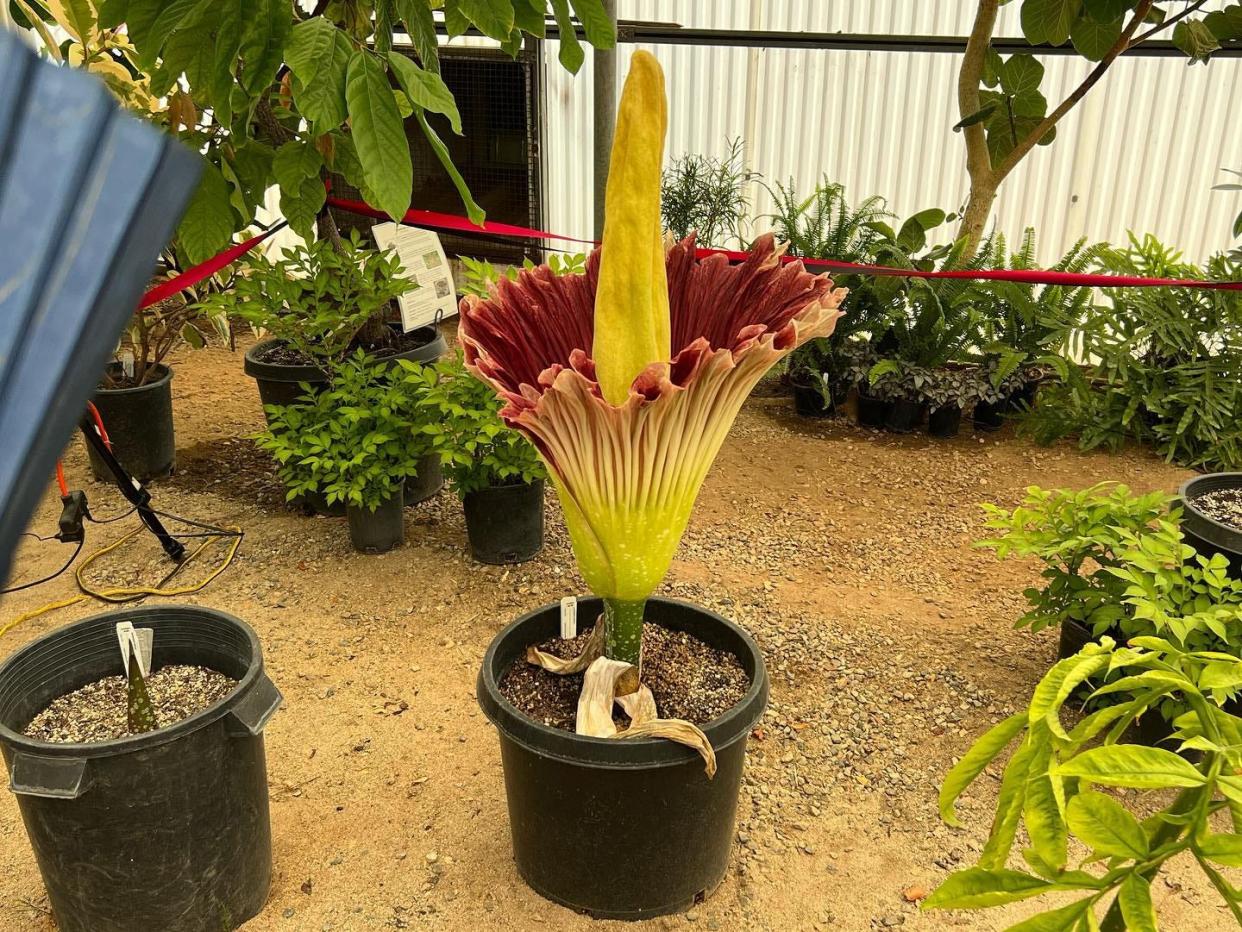UC Riverside's titan arum, or corpse flower, blooms for the first time

Visitors at the University of California, Riverside’s Botanic Gardens were witness to a rare and smelly sight last weekend.
A titan arum — also known as a corpse plant or corpse flower — dubbed “Little Miss Stinky” bloomed in full for the first time since first being grown from a seed in 1999, university officials said.
The plant has been called the “world’s largest flower” and has the largest unbranched inflorescence, or cluster of flowers, on Earth.
At least 1,500 people showed up Sunday at the gardens to see the plant which had bloomed the night before unveiling a rich maroon interior, the Southern California News Group reported.
“It’s starting to stink in here!” the gardens said when the plant first began to open.
The corpse flower is so named because it emits a noxious odor while opening, similar to rotting meat, to attract pollinating insects.
Though it took more than two decades to bloom, the plant – a species which can grow to more than 8 feet tall — had closed up by Monday.
University officials said they were beginning to collect pollen to freeze “for a future flowering event or sharing with other gardens in the worldwide conservation effort to protect corpse flowers everywhere.”
A plant at risk
The titan arum is only known to grow in the wild in the rainforests of Sumatra, an island in Indonesia.
Habitat destruction has led to a population decline of more than 50% over the past 150 years and the species to be listed as endangered, according to the International Union for Conservation of Nature.
There are estimated to be fewer than 1,000 plants remaining in the wild currently.
In 1999, the Huntington Library, Art Museum and Botanical Gardens featured the first corpse flower to bloom in California which was also only the 11th recorded bloom in the U.S.
UCR’s gardens acquired “Little Miss Stinky” in 2007 from the Huntington gardens in San Marino which grows several dozen of the plants in its greenhouses.
One of the Huntington plants, “Scentennial,” bloomed in late June. UCR has four other corpse flowers, two of which have sprouted, according to Jodie Holt, director of the university's gardens.
Holt said Tuesday her team was "beyond excited" for the bloom.
"Our former manager who acquired her has been back every day, and several of us had a midnight watch party for several hours Saturday night to see her open," she said. "We opened the greenhouse Saturday and Sunday and on Sunday had 1700 visitors, a record for us."
A cycle of death and rebirth

For most years of its life, the world's largest flower — isn't.
Over a life cycle of 30 to 40 years, the titan arum will grow into a large leaf resembling a tree which can grow to 15 feet tall. The tree gathers energy from the sun to store into an underground tuber, called a corm, before dying after a year or more.
The corm then remains dormant for several months before sprouting either a new leaf, or a flower which happens once every four to five years, according to the Chicago Botanic Gardens.
A corpse flower can take seven to 10 years to gather enough energy to begin a bloom cycle.
After the brief bloom, the plant will wilt away and produce fruits that are spread by birds in nature. Some of the fruits’ seeds can be planted to grow a new corm.
The corpse flower then enters a period of dormancy and emerges as the tree-like leaf for the next few cycles before gathering energy to bloom again.
University officials said on a live feed they were awaiting the “final crash” of their corpse plant. The spadix, or prominent spike of flowers, of “Little Miss Stinky” remained standing as of Wednesday afternoon.
“We expect the corpse plant to wilt and fall over for a dramatic ending,” officials said. “Stay tuned!”
Daily Press reporter Martin Estacio may be reached at 760-955-5358 or MEstacio@VVDailyPress.com. Follow him on Twitter @DP_mestacio.
This article originally appeared on Victorville Daily Press: UC Riverside's titan arum, or corpse flower, blooms for first time

